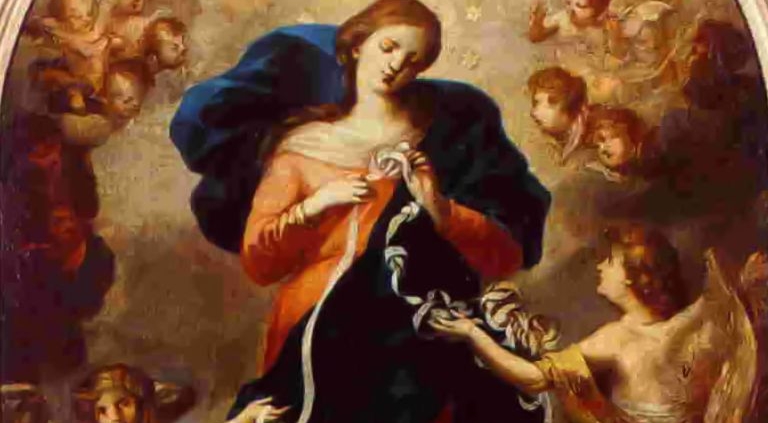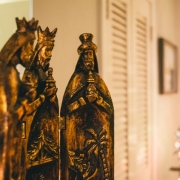Untangling Things by Dr. Michael Murphy
If Catholic and Christian therapists have one primary advantage over secular therapists, it has to be that we have the privilege of knowing that in order to be truly successful with our patients, we must form and reform our lives around spiritual dependency on God’s love. I know, anyway, that there’s no other way I could do it, and I’m certain that my two colleagues at RWPS would agree.
God’s help comes in a variety of forms and through a variety of channels. One special lady I lean on for assistance in therapeutic matters is Mary, Undoer of Knots. To me, Mary is always working behind the scenes (the wedding at Cana, yes?) to bring about God’s glory. Therapy is often about recognizing and disentangling our most recalcitrant psychological knots. The process in some ways is mysterious and requires movements of the heart that neither the therapist nor patient fully understands. To offer more clarity about what I mean, I want to elaborate on the analogy of knots as similar to psychological issues, and therapy as a way of addressing psychological knots. I also want to indicate the assistance Mary, Unoder of Knots procures for therapeutic growth, reordering, and healing.
Knots are complicated. Sure, sometimes you can just vigorously shake a cord free of its tangle, but many knots are not so easily undone. The particular issue that brings a person to therapy is often like this latter, difficult knot. In some ways this is just the way it is, as most problems a person encounters are solvable without the help of a therapist. Until this is not the case, therapy is often viewed as unnecessary. Many people find their problems are a good deal beyond manageable by the time they enter therapy, which naturally contributes to the complexity of the therapy as well.
The solution isn’t always obvious. Loosening restricting knots (physical and psychological) sometimes requires trial and error. A bit of pushing or pulling, on this part or another, results in bits of progress – or not. Progress instills hope and gives the therapist and patient a sense that they are working in the right area. Mary is able to step into this process in a way that can be illustrated in a very concrete manner: The therapist and patient only see the exterior of the knot (or salient features of the presenting psychological issue) – Mary can see the interior. She is thus especially suited to guide our therapeutic efforts; the more complicated the problems, the greater her insight!
Undoing a knot is a process. A lot of knots are left alone because they don’t cause that much of a problem. I think of a wad of cords behind a computer desk, or even a pair of shoes with knots perfectly calibrated for just the right fit. This is rightly normal. But some knots persist even while they disrupt and annoy us (and others). Dealing with these requires more time and effort than we are usually willing to give in the moment. We try to ignore them, and sometimes do so for a long time (even if others can’t help but notice them). But when it comes to finally straightening them out, it takes time and sometimes they are so tangled that the process is a veritable puzzle.
Analogously, unraveling long-standing behavior patterns, ingrained beliefs, and tightly-bound emotions is similar. Patient and therapist are finite in their abilities, no matter how clever or competent. Happily, the therapist and patient are not alone in the work, and so enters the mystery of God’s glory through Mary’s intercession. Our (divinely willed) finitude is bolstered and altogether made-up-for by the Lord’s sufficient graces. These graces come both within and without the therapy room proper, as there are no boundaries to God’s chosen dwelling places. It appears to me, from the changes I’ve seen in patients, that God is characteristically generous with these helping graces, which touch and affect our psychology in unforeseen ways.
Sometimes untangling things leads to a bigger mess (initially). Once the person has sat down and committed to the process, it sometimes becomes clear that there is a lot of work to do. Not only that, but what was in some ways confined to the small area of a knot is now spread out, taking up more space, becoming more noticeable by others and yourself. Psychologically speaking, unveiling things that have been balled-up, over-simplified, unaddressed, or consistently ignored can be stressful, unpleasant, and even quite painful and debilitating. This is the normal course of things for many presenting issues, and Mary can help obtain the appropriate graces to help a person endure. The mess doesn’t last.
Knots are a pain. Therapy is often a great relief to patients at first, and in general. However, real change often involves suffering. Therapist don’t like to see their patients suffer, but are obliged to allow them to wrestle with past rejection, deeply-rooted convictions of sinfulness, and other painful interior experiences in order to find healing. Many of these experiences are analogous to the interior parts of a knot – unseen, neglected, denied parts of the person that are never brought out into the light because they are wrapped up tight and obscured. Even as Mary guides the unveiling of these parts of us, God’s presence accompanies us, bringing meaning and healing to our pain.
My colleagues and I at RWPS strive to know the saving power of God. We have the great grace of knowing that the inevitable suffering that life will dole out has been shared by Christ (God himself). Therapy can sometimes be a microcosm of that reality, but it similarly, though not as essentially, is redemptive. Our constant prayer is that God’s saving grace is infused into our work. I would have little hope for my patients and their brave work in therapy otherwise.










